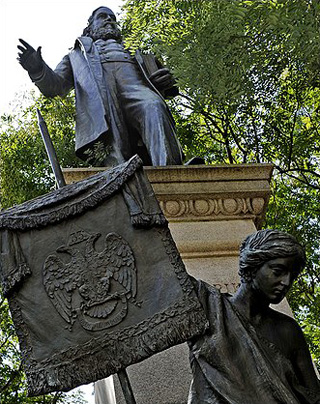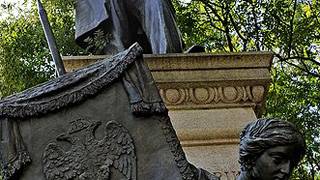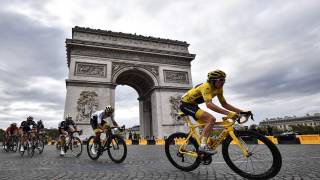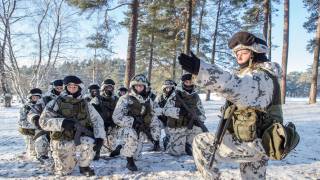Take a Tour of Masonic Washington: What Does It All Mean?
Source: washingtonpost.com
 Albert Pike was a Confederate general. However, it was his service as a sovereign grand commander of the Scottish Rite Masons, not his role in the Civil War, that ensured his spot in Judiciary Square. |
All you need is the secret handshake. Don't know the handshake? Never mind. Neither do we.
Just stand at the curb at Union Station and say in unison the ancient phrase of the Freemasons: "Is there no help for the widow's son?"
Excellent. Come on board our vehicle today, the Esoteric Omnibus, painted black with golden stars, squares, crosses, triangles, pyramids and all-seeing eyeballs.
You know why we're here. Six years after his blockbuster "The Da Vinci Code," Dan Brown's next novel, "The Lost Symbol," will hit stores Tuesday with a massive print run of 5 million copies. The book's contents remain a secret deeper than the whereabouts of the Holy Grail and the location of Christ's genome, but the cover shows a blood-red Masonic seal and the sun glinting behind the Capitol dome.
Hmmm. Masons, Washington. Washington, Masons . . . .
Of course, Brown began dropping clues when he hid the "widow's son" phrase on the dust jacket of "The Da Vinci Code" to allude to his next novel: Masons. There he also disguised an allusion to the enigmatic sculpture Kryptos at CIA headquarters: Washington. There's nothing the author likes better than a secretive society to help weave plots dense with coded knowledge that could change the course of history.
So Brown could have predicted this moment. He must have imagined we'd be taking crash courses on Masonry, poised to scour the nation's capital for symbols and deeper meaning, following the footsteps of Robert Langdon -- the author's tweedy Harvard symbologist hero, who's back in the new novel.
Does the layout of Washington reveal some hidden Masonic influence? Are those secret signs hidden in the construction of key buildings? And what about those scary symbols on the nation's currency?
Let's find out. Touring Brown-inspired Washington Masonry before the novel even comes out may sound crazy, but others have tried.
Masonic historians such as S. Brent Morris ("The Complete Idiot's Guide to Freemasonry") and Christopher Hodapp ("Solomon's Builders") have proposed essential Masonic Washington sites to visit. Old Town Trolley Tours is mulling the launch of a Secret Symbols tour of D.C., based on a concept and 50-page script drafted by Washington writer Warren Getler. Hollywood producers Ron Ziskin and Mark Victor have made a two-hour documentary, "Hunting the Lost Symbol," to air next month on the Discovery Channel. And journalist David A. Shugarts published "Secrets of the Widow's Son," foretelling the Masonic Washington theme, four years before "The Lost Symbol" reached bookstores.
1. The Temple of the Supreme Council of the 33rd and Last Degree of the Ancient and Accepted Scottish Rite of Freemasonry for the Southern Jurisdiction of the United States
Or House of the Temple, for short. It's the massive edifice 13 blocks north of the White House, guarded by two sphinxes.
Inside are vast halls with ancient motifs and Masonic symbols -- the double-headed eagle, the famous square-and-compass with the letter G (for God and Geometry). The number 33 is big: There are 33 columns on the outside, 33 chairs in a ceremonial room. There's also a 33 on the cover of Brown's book, stamped inside a triangle above the Latin motto: "Order out of Chaos."
Here comes Morris, the genial managing editor of the Scottish Rite Journal.
"You can't have a building like this without a cool door like this!" he says as, with a flourish, he pushes against a section of the limestone wall. A hidden door swings open.
Ah! The chamber of deepest secrets, we presume?
"No, roof access," Morris says. "This is where we go to watch fireworks displays."
Darn.
The Masons are cagey about their rituals, but otherwise they don't seem all that secretive. Docents give free tours of the temple. Let's pause for some Masonry 101.
Masons first appeared in Britain in the early 1400s as members of craft guilds. Their "secrets" included how to square a corner and build a cathedral. Claims of a connection to the Crusades and the Knights Templar -- as suggested in "The Da Vinci Code" and the "National Treasure" movies -- are the stuff of fable, historians say. In the 1600s, non-stoneworking gentlemen began joining, and Masonry became fashionable. The Masons encouraged free thought and religious tolerance. They helped invent America: George Washington, Ben Franklin, nine signers of the Declaration of Independence and 13 signers of the Constitution were Masons. Both Presidents Roosevelt and 11 other presidents besides Washington were, too. Also J. Edgar Hoover, Will Rogers, Ty Cobb, John Wayne.
For the roughly 1.5 million Masons in the United States today, Masonic life involves socializing, self-improvement and raising hundreds of millions of dollars a year for charity, Masonic leaders say.
But you only have to visit any number of anti-Masonic Web sites to find the darker claims of conspiracies to rule the world and undermine religion. A persistent rumor involves secret symbols in the map of the city.
2. The L'Enfant Street Plan
Let's drive south on 16th Street toward the White House -- straight into the heart of the Pentagram.
Brown and his publisher have been issuing riddles and ciphers for fans to solve on Facebook and Twitter. One was the word "L'Enfant."
Another consisted of five pairs of numbers, which turned out to be the latitude and longitude for the White House, Washington Circle, Dupont Circle, Logan Circle and Mount Vernon Square. Draw lines on the avenues connecting the points (pretend Rhode Island doesn't stop at Connecticut) and you get a five-pointed star.
For years Masons have wasted a lot of breath pointing out that five-pointed stars may be demonic, but they aren't particularly Masonic.
But wait: It's also possible to divine a six-pointed star on the map east of the Capitol; and a square-and-compass centered on the Capitol. Those are Masonic symbols. Busted!?
A couple of problems: Pierre L'Enfant, who conceived the street design in 1791, was not a Mason, nor was Andrew Ellicott, who executed the layout.
L'Enfant's guiding design principle was to symbolize the democracy by locating the White House and the Capitol on two prominent rises, connecting them with a grand boulevard. The street scheme grew from that.
"So many of the claims are so ridiculous," says Don Alexander Hawkins, an architect and historical cartographer, who debunks the conspiracy theories in a forthcoming essay for Washington History magazine.
On the other hand, Hawkins must admit, the boss who wanted the 10-mile-square city staked out exactly here was George Washington, the Mason.
Brown could work with that.
Did we mention that 16th Street is Washington's "Rose Line"? Brown loves a Rose Line, as readers of "The Da Vinci Code" know. A Rose Line, in Brown's fiction, is a meridian line with mystical significance. Thomas Jefferson (not a Mason) conceived that 16th Street would be the prime meridian for the new world. The meridian line would pass through the White House. He imagined that a monument to George Washington would be placed on the spot where the meridian line intersected a straight line drawn west from the U.S. Capitol. Unfortunately, the Washington Monument had to be located slightly off the Rose Line where the ground was firmer.
Continue the intersecting line from the Capitol across the Potomac River and you hit a place called Rosslyn, which, as "Code" readers know, is also the name of the sacred Templar chapel in Scotland. According to Brown's fiction, Rosslyn and Rose Line are linguistically connected: Rosslyn-Roslin-Rose Line.
So the Masonic headquarters -- built more than a century after L'Enfant went to work -- is on Washington's Rose Line. And at the foot of the Rose Line, in Lafayette Park, the key statues depict Masons, according to Hodapp: Andrew Jackson, Lafayette, Kosciusko, Von Steuben and Rochambeau.
This novel is just writing itself.
3. Statue of Albert Pike
Hiding in plain site in Judiciary Square is said to be the only outdoor statue of a Confederate general in Washington.
But Albert Pike's Confederate leanings don't concern us here. He was also a sovereign grand commander of the Scottish Rite Masons.
His big, bearded likeness is almost lost in the canopy of trees. At his feet is a woman holding a banner with the double-headed eagle, the triangle and the number 33. The 33 is a specific reference to the Scottish Rite. Most Masons are not Scottish Rite. Washington wasn't. The Scottish Rite was founded in 1801 -- two years after Washington died, a decade after the city was laid out. Is Brown imagining a fateful schism among American Masons?
At a book event shortly after "The Da Vinci Code" came out, Getler says he mentioned to Brown that his own recent nonfiction book, "Rebel Gold," concerned a secret society, buried treasure and Pike.
According to Getler, Brown said: "I don't think I should read your book right now. My next book is about Albert Pike."
4. The Capitol
In September 1793, Washington donned a ceremonial Masonic apron and helped lay the cornerstone of the Capitol, a ritual complete with a silver trowel, marble gavel and the sprinkling of corn, wine and oil.
Washington's participation was special for Masons. He was the president of the country, but he was simultaneously being a Mason.
For conspiracy theorists and fiction writers, it could be special, too. Were his loyalties divided?
In his novels, Brown reveres art as a system for communicating secret messages to the initiated. The Capitol, as essentially a massive national art gallery, may have something to say.
High on the Capitol Rotunda's domed ceiling is Brumidi's dramatic portrayal of the "Apotheosis of Washington" -- the Mason ascending to heaven. Of 100 or so statues in Statuary Hall and elsewhere in the building, Hodapp counts at least 30 Masons. And he found a panel on the doors of the Senate depicting the cornerstone ceremony, Washington wearing his apron.
(Speaking of official and quasi-official art, what's the deal with the Great Seal? On the back is an unfinished pyramid topped by the all-seeing eye, as on the back of a $1 bill. Masonic, right? No, says Morris. The final seal design came from a committee of non-Masons. The unfinished pyramid is not Masonic. The all-seeing eye is a Masonic symbol for the creator, but is used beyond Masonry as well, he says.)
Brown also loves a crypt. There's one in the Capitol, of course, beneath the Rotunda. At the center of the crypt is a star. The star marks the spot from which the capital's four quadrants of streets fan out -- the very heart of the L'Enfant street plan with its mysterious meanings.
What else is down there?
5. George Washington Masonic National Memorial
On to Virginia, via the Key Bridge -- not because it's the most direct route to Alexandria, but because it's called the Key Bridge, and that might be key, in a Solomon's Key sense of the word. Also, the Key Bridge leads to Rosslyn, which, well, you know.
Now heading south on the George Washington (!) Memorial Parkway, past Theodore Roosevelt Island, named after another presidential Mason.
The tall lighthouse-like tower of the Masonic memorial dominates Alexandria. Inside is a gigantic bronze statue of Washington in his Masonic apron. It is also the modern home of a still-active Alexandria Masonic Lodge, where Washington was once the worshipful master.
Also in Alexandria is Jones Point, where in 1791, during yet another Masonic ceremony, the first stone marking the outline of the District of Columbia was laid.
6. Kryptos, Central Intelligence Agency, Langley
The perfect Brownian object: A work of art that embodies secrecy and ciphers, designed to adorn the headquarters of a spy agency.
The public can't visit, but the agency has a little Web tour we can call up on our laptops.
Created in 1990 by sculptor James Sanborn, the copper and stone Kryptos has four panels inscribed with letters, concealing four coded messages. Three have been solved. Still encrypted is a message with about 97 characters. What does it say?
Shugarts was among those who spotted the almost-exact coordinates of Kryptos's location on the jacket of "The Da Vinci Code." Shugarts also found on the jacket the phrase "only WW knows," which is part of one of the decoded messages of Kryptos. WW is generally believed to refer to former spy chief William Webster.
Kryptos is seemingly a big step from the Masons -- unless WW stands for William Wirt, who ran on the Anti-Masonic Party ticket in 1832, and whose skull was supposedly stolen from his grave. The skull and bones were reunited by Smithsonian anthropologists. "Who stole William Wirt's skull?" was another pre-publication clue.
Meanwhile, they are ransacking Washington for other coded art. Some say artist Albrecht Durer figured in a Twitter clue. "Lost Symbol" hunters say his "Melencolia" -- which is at the National Gallery of Art -- contains Mason-like symbols, even though Durer predated the Masons. "Melencolia" also contains a "magic square" -- a puzzle, believed to have mystical meaning, where rows of numbers add up to the same sum.
Prediction: Somewhere in "The Lost Symbol," a guy in a raincoat wearing a Masonic ring is going to be sitting on the Metro at the L'Enfant Plaza station working a very strange Sudoku puzzle.
This can go on and on, which is what keeps us turning the pages, until it ends.
Source: washingtonpost.com






















